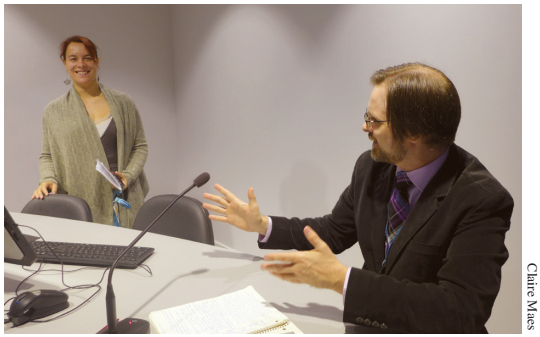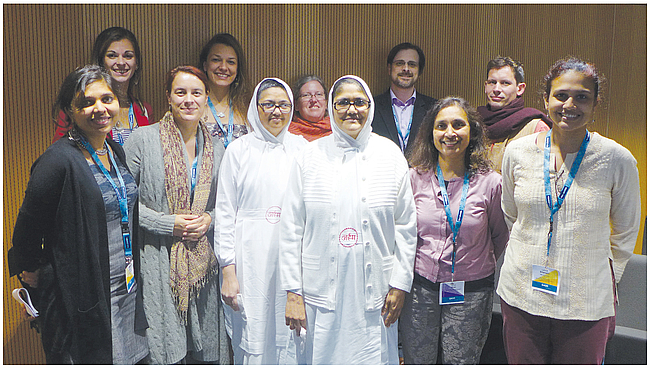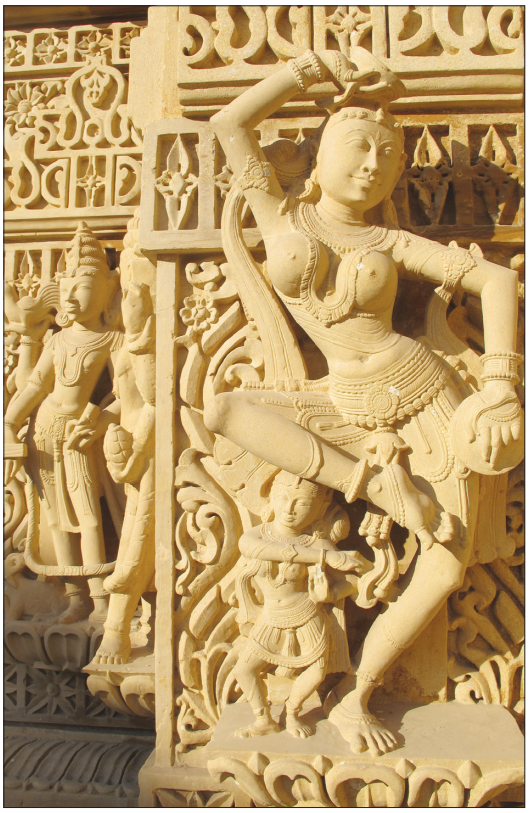
Centre of Jaina Studies Newsletter: SOAS - University of London
This year's meeting of the European Association for the Study of Religion Conference (EASR), held at the Catholic University of Leuven from 18-21 September 2017, hosted as many as eleven international scholars to discuss topics on Jainism. Since the Conference centred around the communication of religion, Tillo Detige, Tine Vekemans and Heleen De Jonckheere (all Ghent University) organised a panel titled Communicating Jainism: Media and Messages.
Steven Vose (Florida International University) opened the first of three sessions, Communicating Jainism: Theoretical Perspectives with a paper titled 'Reflections Toward a New Approach to the Anthropology of Jainism' in which he discussed current tensions in Jaina Studies between the relatively recent scholarly 'lived tradition' approaches and approaches preferred by certain Jain groups that focus on doctrine and beliefs. Taking a short tour into the history of Jaina Studies, he explained how older scholarly analyses mostly centred around beliefs and doctrines of Jainism, while disregarding Jain practices. An important turning point was John Cort's PhD dissertation Jains in the World: Religious Values and Ideology in India (completed 1989, published in 2001). Instead of studying Jainism, Cort studied Jains using anthropological and historical approaches. Some thirty years later this 'lived tradition' approach is well settled in the field of Jaina Studies. However, with chairs in Jaina Studies becoming more prevalent at US universities, and the annual Jain Summer School, ways of thinking about Jainism by (mostly wealthy male) Jains, especially in the diaspora, characterized by a focus on doctrine and text, start to influence academic work more heavily. Therefore, Steven Vose suggested an 'anthropology of Jainism' alongside an 'anthropology of the Jains' in future studies, by which scholars would work collaboratively with Jain communities, while explicating influences of such relations within Jaina Studies.
Tillo Detige (Ghent University) in 'Commu(nica) ting Selves: Dancing Devotees & A Practice Theoretical Approach to Jainism' questioned whether it is practice or theory which comes first in Jainism and which should therefore also be prioritized in scholarly descriptions of the tradition. He advocated an approach towards the study of Jainism that looks at their media of knowledge transmission. Detige proposed to put ritual and devotional practices, story-telling, meditation, songs and dance, pilgrimage and dietary practices first in the study of Jainism, analysing how these 'technologies of the self' construct practical, experiential, relational and embodied knowledge. In this way, Detige suggested a turn away from a scholarly focus on beliefs and reified doctrines, shifting instead towards Jainism as 'lived tradition' with a focus on its material, sensory, performative and emotional aspects.

Steven Vose and Tine Vekemans
Tine Vekemans' (Ghent University) presentation, 'Learning Jain Online: How New Technologies Impact Upon the Practice-Theory Equilibrium,' explored how research on Jain online media could contribute to the discussion about a practice or doctrine focussed approach in the study of Jainism. Referring to the panel title Vekemans suggested that each medium for learning Jainism favours a certain type of message. In diasporic contexts, where Vekemans' research is set, learning Jainism takes very different forms in comparison to Indian contexts where munis, temples, etc., are easily accessible. Jains in the diaspora therefore use other ways of learning Jainism such as reference books, pāthśālās and, with its growing popularity, online media. From an examination of digital media it appears that older online media were mostly text-based containing descriptions of Jain philosophy and teachings, while newer media include more interactive elements. This shift impacts upon the conveyed message in that it reflects a turn from doctrine toward practicing Jainism.
The second session on written texts, Communicating Jainism: Storytelling, Wordplay and Literary Composition, was opened by Heleen De Jonckheere (Ghent University) who in her paper 'The Story of the Stories within the Story: Narrating Jain Selves' discussed how one narrative text, the Dharmaparīkṣā by Amitagati (1014 CE) both reflected and transformed the Jain tradition. The Dharmaparīkṣā, a collection of stories aimed at criticizing Puranic Hinduism, seems to reveal aspects of what it meant to be a Jain at that time. The opening theme is the concern about 'false belief' (mithyātva), while the inner core seems to comment more upon everyday morality and behaviour. Also dominant are motives from the Purāṇas and epics that show the Jains' concern with popular Hinduism. By both including and criticizing these stories the author of the Dharmaparīkṣā uses a double strategy of denying the authority of and also opposing the Hindu tradition. De Jonckheere argues that with these different layers the Dharmaparīkṣā shows the richness of Jain narrative literature, using didactic motives and popular material, and adapting to changing environments, thereby transforming and perpetuating the Jain tradition.
In her presentation 'The Transformative Nature of Hymns: A Twelfth-century Jain Monk's Usage and Conceptualization of Stotras' Lynna Dhanani (Yale University) examined the relationship between stotra and narrative, focusing on a portion of Hemacandra's Vitarāga-Stotra that appears in the biography of Mahāvīra found in his Triṣaṣṭi-śalākā-puruṣa-caritra. Presenting current research that has discovered over half of theVītarāga Stotra embedded within both the Ajitanātha and Mahāvīra caritras, Dhanani showed how Hemacandra's placement of stotra within biography reflects both a continuation of a tradition of embedding stotras at the moment of an auspicious life event or kalyāṇaka in the biographies of Jinas and his expansion of the use of stotra within this genre to include them in events occuring outside of a kalyāṇaka. The paper examined one such instance by showing how stotra was used to advance the narratives concerning Gautama's omniscience and the testing of the laywoman Sulasā's faith in the Jina's teachings, as one example of the ways in which medieval monks were experimenting with and extending the use of stotra.
In 'Playing with Words when Stating an Inference: The Practice of Patra in Jainism' Marie-Hélène Gorisse (Ghent University & SOAS) presented the theory of patras or puzzle-arguments using two Digambara Jain texts, the Patraparīkṣā by Vidyānanda and the Prameyakamalamārtaṇḍa by Prabhācandra. A patra is an inferential reasoning expressed by means of statements not directly comprehensible as such and is thus very difficult to understand by an audience unfamiliar with this type of argumentation. The difficulty is strengthened by a puzzle of coding techniques such as periphrastic presentations of concepts, alternative analysis of expressions, alternative meanings of words, references to lists and other references. This all requires that the receiver of a patra has a lot of background knowledge, which is probably why patras are so rarely found. However, according to Gorisse, patras have some benefits: they ensure the reliability of the debater, with their multiple possible meanings they train the listener in a sensitivity to the Jain concept of non-onesidedness, and they 'embody' the connections that in the Jain view exists between all complex objects of knowledge. As such, the practice of puzzle-arguments is in line with the Jain perspectivist teaching of non-onesidedness.

The last session of our Jain panel, Communicating Jainism: New Media, New Messages, brought us back to modern times. In 'A Real Tirth Has a Website, A Real Tirth Needs No Website: Using Media to Build Temple Prestige' Whitney Kelting (Northeastern University) revealed a change in websites on Jain pilgrimage sites using the Seth Ananda Kalyanji Trust website as example. Just a few years ago (before about 2014) online sources on Jain pilgrimage sites were rare, as people used pilgrimage guidebooks and their common knowledge about Jain festivities to go on pilgrimages. However, very recently sites such as jinalaya.com and gojainyatra. com have appeared providing online users with broad information on Jain tirthas and methods for online booking of taxis and dharmaśālā rooms. In reaction to this phenomenon the trusts of some pilgrimage sites, such as the Ananda Kalyanji Trust, have published their own website with detailed information and festivity dates of specific tirthas linked to their trust (e.g. Shatrunjaya). In this way the Trust claims control over access, information and prestige surrounding the pilgrimage site, asserting its legitimacy in response to the new unofficial websites. In 'Communicating Heritage: Construction of Tamil Jain Identity in Print and Social Media' Mahima Jain examined the role of different modern media in the construction of contemporary Tamil Jain identity. Looking at extracts from The Hindu the overall illrepresented Tamil Jains are mostly portrayed as a community from the past, given that articles on Jain heritage and history dominate print media. This neglects the fact that Tamil Nadu still has a lively Jain population. Therefore, Tamil Jains have turned to social media to voice their interests and identity as Tamil Jains. Even if discourse on heritage is also here strongly present, media such as Facebook and WhatsApp have given the Tamil Jain population the opportunity to talk about themselves and their own pilgrimage experience. As such reflecting the need of Tamil Jains to identify and show themselves as Tamil Jains with their own characteristics, different from northern Jains.
In 'Narratives of Jain Religiosity or of Humanitarianism: Understanding Jain Diaspora Philanthropy' Bindi Shah presented her fieldwork with a Jain socio-spiritual organisation, TripleS, focussing on the meaning people in this organisation have given to diasporic philanthropy. TripleS was founded with the mission of doing sevā (selfless service to the poor) as a reinterpretation of the Jain path to liberation. A large part of this sevā is transferring donations (dāna) from Jains in the diaspora to several education and health projects in India. From interviews with donators to TripleS it appears that a number of motivations lie behind the donations, like feelings of equality and passing on Jain norms of compassion to younger generations. Through this dāna Jains in diaspora are able to practice their religiosity in the modern world and carry Jainism to younger generations.
At the end of a day full of thought-provoking presentations, Samani Pratibha Pragya (SOAS) talked about the 'Role of Media and Manpower in Dissemination of Prekṣā-dhyāna.' She argued that the meditative practices, called prekṣā-dhyāna, developed by Ācārya Mahāprajña and further promoted by the Jain Terāpanth saṅgha, engage in a cultural process shared with twentieth-century yoga gurus to promote their own meditation or yoga package in the contemporary world as a tool for holistic development and solving 'everyday' problems of the individual. The Terāpanthis promote their prekṣā-dhyāna through various means such as national and international camps, trainers' sessions, celebrating a prekṣā day, building prekṣā meditation centres, and publishing special magazines, websites, apps, television shows, etc. Samani Pratibha Pragya analysed these various methods with their varying strategies therein to look at how the Terāpanthis promote and spread their meditative practices in the modern-day world.
Every paper of the session Communicating Jainism: Media and Messages was followed by a lively discussion encouraging both speakers and audience to think further on topics ranging from theories toward Jain studies to Jain meditation. More discussion and new ideas were shared during an informal conference dinner. We hope this will foster good connections between Jain scholars and perhaps inspire new challenging research.
In a separate conference panel on Religion, Spirituality and Mental Health Samani Unnata Pragya also presented at this year's EASR with a paper 'Communication with the Jina through Samudghāta and non-Samudghāta Method.'

Pārśvanātha Mandira, Śaṅkheśvara. Photo: Ingrid Schoon 27.12.2015
Heleen De Jonckheere is a PhD candidate at the Department of Languages and Cultures of Ghent University in Belgium. Her research deals with Jain narratives and inter-religious, literary dialogues in medieval North India, focusing on the genre of Dharmaparīkṣās.
 Heleen De Jonckheere
Heleen De Jonckheere